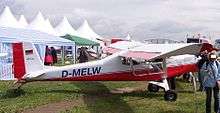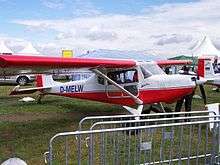ULBI Wild Thing
The ULBI Wild Thing is a German ultralight aircraft, designed by R. Kurtz and produced by Ultraleicht Bau International (ULBI), of Hassfurt. The aircraft was supplied as a kit for amateur construction or as a complete ready-to-fly-aircraft.[1][2][3]
| Wild Thing | |
|---|---|
 | |
| WT 01 Wild Thing | |
| Role | Ultralight aircraft |
| National origin | Germany |
| Manufacturer | Air-Max GmbH ULBI |
| Designer | R. Kurtz |
| Introduction | 1996 |
| Status | Production completed (2014) |
| Number built | 75 (1998) |
| Unit cost |
€62,930 (2014) |



In the 1990s the aircraft was marketed by Air-Max GmbH of Nuremberg, Germany.[3]
The aircraft was introduced in 1996 and production ended when ULBI went out of business in 2014.[1][2][4]
Design and development
The aircraft was designed specifically for touring in Africa. It was intended to comply with the Fédération Aéronautique Internationale microlight rules. It features a strut-braced high wing, a two-seats-in-side-by-side configuration enclosed cockpit with doors for access, fixed tricycle landing gear or conventional landing gear and a single engine in tractor configuration.[1][2][3]
The aircraft is made from sheet aluminum. Its 9.15 m (30.0 ft) span wing has an area of 13.88 m2 (149.4 sq ft) and flaps. Standard engines available are the 100 hp (75 kW) Rotax 912ULS, 85 hp (63 kW) Jabiru 2200 and the 120 hp (89 kW) Jabiru 3300 four-stroke powerplants.[1][2] The 100 hp (75 kW) Hirth F-30, 75 to 80 hp (56 to 60 kW) Limbach L2000 and the 180 hp (134 kW) Lycoming O-360 have also been fitted.[3]
Variants
- WT 01
- Conventional landing gear-equipped model[1][2]
- WT 02
- Tricycle landing gear-equipped model[1][2]
Specifications (WT 02)
Data from Bayerl and Tacke[1][2]
General characteristics
- Crew: one
- Capacity: one passenger
- Length: 6.49 m (21 ft 4 in)
- Wingspan: 9.15 m (30 ft 0 in)
- Wing area: 13.88 m2 (149.4 sq ft)
- Empty weight: 290 kg (639 lb)
- Gross weight: 472.5 kg (1,042 lb)
- Fuel capacity: 80 litres (18 imp gal; 21 US gal) in two 40 litres (8.8 imp gal; 11 US gal) wing tanks
- Powerplant: 1 × Jabiru 3300 six cylinder, air-cooled, four stroke aircraft engine, 89 kW (120 hp)
Performance
- Cruise speed: 170 km/h (110 mph, 92 kn)
- Stall speed: 58 km/h (36 mph, 31 kn)
- Never exceed speed: 200 km/h (120 mph, 110 kn)
- Rate of climb: 6 m/s (1,200 ft/min)
- Wing loading: 34.0 kg/m2 (7.0 lb/sq ft)
References
- Bayerl, Robby; Martin Berkemeier; et al: World Directory of Leisure Aviation 2011-12, page 83. WDLA UK, Lancaster UK, 2011. ISSN 1368-485X
- Tacke, Willi; Marino Boric; et al: World Directory of Light Aviation 2015-16, page 86. Flying Pages Europe SARL, 2015. ISSN 1368-485X
- Purdy, Don: AeroCrafter - Homebuilt Aircraft Sourcebook, Fifth Edition, page 104. BAI Communications, 15 July 1998. ISBN 0-9636409-4-1
- "Internet Archive Wayback Machine". archive.org. Retrieved 11 September 2015.